Making movies. Enjoying movies. Remembering movies.
Related Articles:
Coronado or Bust: Producing-Volker Engel and Marc Weigert
Filmed In Panavision Digital-Sony's Larry Thorpe
Meeting A Master Of The Matte-Harrison Ellenshaw
Raiding The Mind Of Richard Edlund
George Lucas And His Magicians Are Honored In Hollywood
|
Posted September 27, 2004 |
|
Coronado or Bust: Visual Effects An Interview with Volker Engel and Marc Weigert |
By
William Kallay
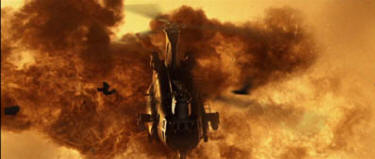
Volker Engel and Marc Weigert formed a production company called Uncharted Territory. Through their concept, they would produce not only feature films and mini series, but would produce and supervise the visual effects for them as well. Engel and Weigertís film, "Coronado," boasts some recent visual effects technology that puts the film on par with the bigger films of the summer of 2003. As previously discussed in the article Coronado or Bust: Producing, the pair have quite an extensive background in visual effects work. This is the second half of an interview with them.
William Kallay, FSTD: Was the whole film shot here in Southern California, or did you go on location?
Marc Weigert: There was some footage here, but that was too radical. We looked at a couple of locations here, but the movie takes place in a Central American country. We decided to go to Mexico for the first unit shoot because we got the location set that we needed. It also takes place in a couple other countries. Thereís a part that takes place in Beverly Hills. Thereís a part that takes place in Switzerland. Thereís a bigger sequence in Switzerland. For that, we only sent a studio unit to shoot background plates. None of our actors were in Switzerland. We did it by being clever in our set ups. Sometimes you have your main angle on the actress, but sheís actually in Mexico City standing in for Zurich. And then in the reverse angle, we composite her into a Zurich plate that was shot by our studio unit.
FSTD: Was it hard for the actors to do a lot of acting in front of a blue screen?
Weigert: I donít think so. We were very prepared. We would show them exactly what the scene would look like. We had the entire movie storyboarded with 1500 storyboards. We had 45 minutes of computer animated pre-visualization [pre-vis] in animatics. We would show them how it was going to look by watching a simple computer animated version. Claudio, the director, spent a lot of time with them. He would explain to them that they were going to be up on a blue screen, but they were really on 400 feet high bridge looking into this valley.
Volker Engel: We would pop in a VHS tape on the set in the morning before started shooting and said this is the seven minute bridge sequence.
FSTD: For your other work like "Independence Day" and "Godzilla," did you have the ability to show the actors pre-visualization?
Engel: Thatís the big disadvantage. I think on "Godzilla," we had a sequence on Brooklyn Bridge was pre-vised. That was it. Itís amazing how these big, blockbuster movies that the preparation time is very compressed. There are several movies out there where a lot of sequences are pre-vised now. But especially in 1995 and 1997, when we did those movies, we didnít do that at all.
FSTD: When did ďpre-visĒ come into the visual effects venacular?
Weigert: When we did "Independence Day," we did some pre-vis. We did some of the sequences in the computer. The thing is that it got a more affordable. At the time, for instance, you had buy an SGI workstation with alias/Wavefront on it. It would probably cost you about forty grand. Factor that in, plus the cost of the people who are actually in front of it, thatís a huge investment. Now you can get Maya or 3d Studio Max with a workstation for four or five grand. After that, you sell it afterwards for two-and-half [thousand dollars]. And there are more schools that teach computer animation, especially for pre-vis. You donít need super seasoned person there if you just want to have a graphical representation of what your shot is.
FSTD: Do you prefer to use storyboards on your work, as opposed to pre-visualization, or is that one and the same kind of concept?
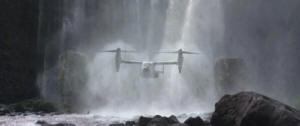 |
|
Waterfall Sequence |
Engel: Both. We start with boards and then we go to pre-vis from there. You donít have to pre-vis everything. Obviously, the dialog sequences are going to be [done without pre-vis]. In "Coronado," thereís a bar scene where everybody was talking. We pre-vised that, but you want to take your logistically challenging sequences into pre-vis.
Weigert: You have to start with storyboards. Those storyboard artists now are trained to know exactly what kind of an angle that you can choose to make a scene work. And they have to do that by themselves, then you can give them to a pre-vis artist and say, ďBring this to life.Ē
FSTD: "Coronado" was shot in digital 24p HD. Can you talk about your experience with shooting in digital, as opposed to film?
Engel: Starting with the fact that many people warned us that we shouldnít shoot blue screen in 24p HD. Youíre dealing with compression artifacts and itíll be hell for compositing. So we did a test and Marc did a test before we started shooting just for a day with some green screen and some blue screen. We found out it works just fine and in the end, for us, it was so much easier to do 24p HD blue screen composites than do 35mm composites.
FSTD: Is that due to the fact that itís all digital and you composite everything together rather than photochemically?
Engel: Oh you donít do photochemically anyways.
Weigert: At all anymore.
FSTD: Nobody does that anymore?
Weigert: No, but what you find if you compare film stocks, for instance, with digital, you always get film grain. So even if you scan in at 200 ASA film stock, you still get more film grain than you would get digital noise on HD.
Engel: Thatís true.
Weigert: Digital is generally cleaner. Itís quite a bit cleaner. Thatís helps a lot. The other problem is that if you have fairly strong film grain in there, especially when you get film that is slightly underexposed, it gets worse and worse. You push it up, you push the grain up. Thatís when you get fairly bad close-ups when you can see that hair detail. That flickering is usually grain. But you still have to deal with digital noise. Itís not as if digital is totally clean, obviously, but itís quite a bit better in comparison that we noticed in film.
FSTD: Did you use the first generation Sony 24p camera, or did you use the second generation?
Weigert: It was the first generation. We had the 900s, the first generation. I think the second is the 950.
Engel: We used the ones that [George] Lucas used for "Episode II" ["Attack of the Clones," 2002]. Heís now using the next generation for "Episode III."
Weigert: Which weíd love to use, but they have them all!
FSTD: There are some new cameras that are coming out from Dalsa. Olympus has a prototype camera that goes up to 4K [resolution].
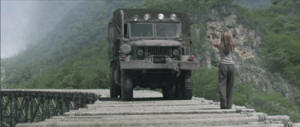 |
|
Kristen Dattilo in "Coronado" |
Weigert: I havenít seen the Dalsa camera. I have seen the 4K. The problem with those is that there is no tape medium to record to yet. You have to record to hard drives, which is very expensive. But we were thinking about it. Theoretically, recording to hard drives would be great. You donít even have to put in tape anymore. You just have it all directly online. It sounds gorgeous. But the problem is itís not doable. If you calculate, for instance, on any regular feature, you have at least a hundred hours of footage that youíve shot. Thatís a minimum. We had about 100 hours for "Coronado" and only 36 shooting days. If you have 60 shooting days, you have to use it more. With a 100 hours, the amount of drive space you would need just to store your original negative, it will cost you about $100K just to store it. On top of that, you need a data back up. Trying to back that up to tapes is so slow and also expensive. Any of the cameras that require hard drives are pretty much unpractical.
FSTD: You basically replace your computer workstations after each show. Is that because they become outdated at some point?
Weigert: From one shoot to the next, thereís at least a year in between projects. So in that year, you can pretty much almost throw your equipment away. So what weíll do is buy it when we need it. Whenever a new artist starts, we get the machines about a week before. Then immediately when the artist is finished, we immediately sell the systems. With that you still get a minimum of fifty cents on your dollar. Itís cheaper than renting. In the end, you get the newest equipment and newest software, which most visual effects companies cannot afford. They cannot afford to change their equipment constantly.
FSTD: When did you start using computers on your visual effects?
Engel: On "Independence Day," which was a mix of a lot of miniature work that would get composited together.
Weigert: Youíre forgetting some of the stuff we did in Germany back in the film school days. We had an Abacas system which was basically a computer based system in the early nineties.
FSTD: Did you find using the computers was a lot easier to work with compositing effects rather than doing it optically?
Engel: I actually did one movie where I did some opticals and yes, itís a pain in the butt, no question. Now looking at the stuff ILM did on "Return of the Jedi" [1983]Ö
Weigert: You have to tip your hat!
Engel: Itís a marvel when they talk about, ďYeah, we had these 47 elements in this one shot.Ē All of that was space effects, and so it was a little easier to composite. But still, to keep track of all that? Youíre dealing with analog, so whatever you do, the picture deteriorates. You start with a film strip and then with an optical printer, you make a copy. Whatever you do, the more layers you add, the more copies you do, you have no real means to adjust it. Itís basically trial and error. You try anything based on experience that looks good. Then you develop the film and look at and see that the constrast is not bright, try it again. Now, [with digital HD] what you see is what you get pretty much get. You scan your image in, if you have 35mm film, or with digital images, you have everything right there on the monitor. You calibrate your monitor correctly and you this is how itís going to look later on the big screen. One thing that is interesting for us that weíve learned on Coronado, itís a fact that why weíve kept everything digital, we had total control. We could always bump color correction, which we actually did at E-Film. From our finished product, we then went out to a film negative. So we did everything completely digital. But we knew at the end we would need a 35mm negative so it can be screened.
Weigert: Pretty much what everybody will tell you now with the digital cinema screens is that they all look exactly the same.
Engel: This is what itís supposed to look like.
Weigert: I just saw "Finding Nemo." If you see that digitally projected, then see it in 35mm, itís like day and night.
FSTD: Absolutely.
Weigert: Itís a huge difference. All the colors are vibrant and are exactly the way they should be. With 35mm, itís a mass copy that gets printed somewhere. You never know what youíre getting.
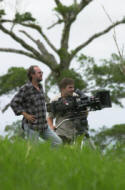 |
|
Engel and Weigert |
FSTD: Itís hit and miss. It definitely is. Thatís one of the frustrations when I go to the movies. Itís like, ďIs it going to look really bad?Ē
Weigert: You never know.
FSTD: There is a difference between seeing a digitally produced movie in 35mm and digital projection. In 35mm, at least in my eyes, it has a soft sheen to it. But when you see it digitally, it pops out at you more.
Weigert: Thatís the advantage of having an entirely digital pipeline. First itís about the acquisition of the images. With 35mm, you have to scan in all the different elements. You need to color correct them. You need to put them together in the computer. You need to output them back to 35mm and then you need to color correct them again. With digital, you donít have to do that. Itís right there. You capture it from the tape. You load it over the network for everybody and put it together and thatís really it. Iím really looking forward to the day when 35mm is gone.
FSTD: Really?
Weigert: Yes. I like the look. We all grew up with it. But right now with digital, you can get the same look. I donít like video.
Engel: I just want to say that I agree with him.
Weigert: We are film lovers.
Engel: But we arenít video lovers.
Weigert: Video is horrible. You have that whole issue with lines and fields and so on. I think video looks horrible. I donít want that. I want the film look, but a stable one.
Engel: The first day our editor Peter S. Elliot saw footage of "Coronado," he said it it looked like 35mm.
FSTD: Well doesnít it also depend the way you shoot it, too? Sometimes some shots might look a little bit more ďvideo-ishĒ than others.
Weigert: Not really ďvideo-ish.Ē But you have to be careful with the exposure. Thatís the big disadvantage right now with 35mm in that you donít have the range of contrast, so itís easy to overexpose. You have to very careful with your settings. But then again, what you see is what you get.
Engel: You donít have to run around with your light meter all the time. Like he said, what you see is what you get. Itís not brain surgery when it comes to that.
Weigert: Itís more transparent for everybody, which is why I think a lot of DPís donít like it.
Engel: They donít like that.
Weigert: You donít want to do that way, but theoretically everybody can stand around the monitor and say, ďOh, this doesnít look good.Ē And actually it doesnít look good because what you see is what you get! You can stand around a little 35mm video tap and you it doesnít look good, then theyíll all say, ďWell, yes on a video tap, but later on the screen itís gonna look better and we color correct it and whatever.Ē Well, with HD, thatís the way it looks. Of course you can still color correct it, but if it looks crappy, itís really going to be crappy. Thatís one of the big problems that DPís have with that format. They like to keep it more secret.
FSTD: Have either of you worked with any VistaVision or large format cameras?
Engel: On "Godzilla" we had VistaVision camera for the flight over the city. The thing is itís always such a pain, because you have to go through a certain facility to watch your dailies. We never used it on "Independence Day" and then only about 5% on "Godzilla."
FSTD: Do you find working with Super 35, which is what "Indepenedence Day" and "Godzilla" were filmed in, to be a positive format to work with, or do you prefer shooting in anamorphic, or flat 1.85:1 or 24p?
Engel: I never made the decision. It was Rolandís as the director. He loves that format [Super 35]. He thinks itís good enough for everything. Super 35 is nice format because you have a lot of space on the top [and bottom] of your frame. Because essentially if you go out back to CinemaScope in the end, youíre kind of cropping the picture in half. For us itís great if we have almost twice the picture available. So now we can do post moves, like pans and tilts.
Weigert: A lot of times just to make it easier for visual effects, you have to shoot locked-off. Today if you do a locked off shot, it really screams ďvisual effects.Ē So you always want to have your camera at least slightly moving. Even if you canít, for whatever reason, you can still do it later in post.
Engel: We could do that in "Coronado" because our shooting format was 16x9, but our end result is 2.35:1.
Weigert: So itís like shooting in Super 35, only digital is in the 16x9 aspect ratio.
FSTD: Letís talk about your roles in visual effects. Going back to "Independence Day," for example, what was your relationship to the director?
Engel: The first thing I have to say about that is that Iím so damned lucky that I worked with a director like Roland Emmerich, because heís probably the nicest director you can imagine to work with. Heís very conscience of all the visual effects. There are so many other directors out there who might say, ďWell, visual effects are an afterthought.Ē You can not do that with a movie like "Independence Day." I was actually thinking about that. I was the third person to read the script from everybody who was involved in the production. They actually sent me the script in Germany. I was living in Germany at that point. So I got it two days after they were finished with that first draft. And then the whole discussion process started.
FSTD: Were there any other perks working with Roland?
Engel: I got my own directorís chair next to his directorís chair, I mean literally with my name written on it, which means something in Hollywood. You get taken so seriously. Sometimes the effects budget on a movie of that scale is between a quarter or a third of the whole budget of the movie. If you have a director who knows all that, it makes things much easier. So we had that very close collaboration.
FSTD: Did you work independently from him?
Engel: On "Independence Day," we we also had a second unit director who shot some thing, and then Roland himself shot many background plates. We had four different crews shooting all the miniatures. My co-supervisor, Doug Smith and myself, had two shooting crews for the miniatures here in L.A., while Roland was somewhere else shooting. We had our hands full for nine months just shooting visuals for the movie.
FSTD: When do you decide to shoot with miniatures as opposed to doing CGI effects?
Engel: Itís your education which tells you what is best. Now there is a tendency, of course, to tend more towards the computer. The computer is not the answer to everything. Thereís a lot of things. If you want an example, everything that has to do with destruction, you probably want to do 80% of that ďrealĒ in some way. If itís a scale miniature or something real. It gets more and more in the direction of have the computer do stuff, we have it do simulations and so on. Everything thatís more random, like fire; more organic. At the moment, weíre experimenting with water more and more because of the plug-ins in the software get better and better. But still thereís something to be said about the touch of an artist, compared to creating something from scratch in CG in the computer. Thereís still worldís of difference, especially when you want something organic.
Weigert: Just little things. If you just look at this picture right there [pointing to an artist rendering on Volkerís desk] of the current movie weíre working on. Thereís a lot of wood and carving. You know how it looks if you see a wood carved figure. There are splintersÖlittle things. When you work with a miniature, you proably would actually take a real piece of wood and you would carve it. But in the computer, you would have to create it. In the computer, you can make and entirely 100% round cylinder, but itís mathematically 100% round. Now you have to go from there and every little piece you have to put there. That takes you so long. A sculptor does this in a day. You say, ďDo I have to have an artist sit there for two weeks on a computer and try to do this?Ē And it still might look a little digital. Or will I just have a sculptor work for one day on it? That will cost me still only half of what it would cost in the computer.
FSTD: Do you ever combine miniatures with CG?
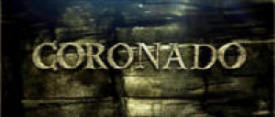 |
Weigert: With this current new picture weíre doing itís a kind of a hybrid between the two. We actually have the miniature company build miniatures, then we scan them in 3D and then use them in the computer. We get all the paintings and the textures on the miniatures. We get all the details, every single bit, but we have it in the computer. So we have the best of both worlds. We have the real nice detailed miniature and we have the option to do camera moves, whatever we want. Weíre totally free on the set. We just 3D track the camera later and put in what we need. Thatís kind of a new thing. Scaning has been out there for so long. Tracking gets easier and easier. It used to be a pain a couple of years ago. Now itís getting better and better.
Engel: We just had a meeting with the company who did all the miniatures on "Coronado." We talked about the new stuff.
Weigert: We have them build partial miniatures, and then we duplicate them in the computer to make an entire village, for instance. We donít have to build the whole thing. There are several different houses, then we multiply most of those in the computer. The main thing is that we have total freedom with the camera. No director these days wants to be locked in anymore.
Engel: Sometimes you shoot motion control. If you have an aerial shot of this here [shows me a drawing of a castle], you follow the flight path of a falcon and you shoot this as a complete miniature, in motion control.
Weigert: Also cost-wise everything that you shoot, youíre talking about a whole crew, even if itís just miniatures. Itís a small crew, but itís a crew. You have camera costs, motion control costs, the studio, lights. You need a lot of lights if you shoot the miniatures in a studio. Even if you have small crew, easily there at $15,0000-to-$20,000 a day. A day of motion control, if youíre very, very lucky, you get two shots.
FSTD: Thatís it?
Weigert: Usually what weíre calculating to get one shot. Because a lot of times with motion control, you need to create three different passes. A lot of times you create a so-called ďdupeyĒ pass, which is a regular lighting pass. Then if itís a nighttime thing, or with "Independence Day," the destroyers with all these little tiny lights on them, you do a light pass, which means you switch everything off. Everything is dark. You only see those little lights, which you could not film because you wouldnít be able to see them because theyíre so dim. So you have do long exposure, so you expose like a minute per frame. In other words, the whole pass takes two hours.
Engel: My DP on "Independence Day" came to me, for instance, and had this list of twelve passes and I would cut it down to five to the most important pass.
Weigert: Yes, exactly. A matte pass, also. Blue screen, backlighting. So you have all those things. If you get one shot per day, itís costs you $15-grand per day and of course the longer you shoot, the cheaper it gets. But no matter what, just shooting the element cost already $10,000 for a single shot. Now you havenít scanned it yet. You havenít run them through the computer. You havenít shot the other elements. You havenít composited yet and so on. So easily you can say that the shot, no matter what you do, will never be done for under $20,000.
FSTD: Do you guys have a shooting schedule once the whole productionís off and running?
Weigert: Actually doing a schedule for visual effects is very, very difficult. You have to first rely on some elements that are coming from first unit [production]. Letís say you have your main actors there on the blue screen for a visual effects shot, but itís in the first unit schedule. Some things are second unit. You might have a battle scene where you have to extend stuff, so second unit will shoot it probably at the same time. Then sometimes you have visual effects splinter units. On "Coronado" it was just the two of us, a driver and a camera assistant. We went into the jungle and shot all the waterfall and jungle footage we needed. You might have the miniature unit just shooting the miniatures. And then you have all your computer animators and your compositors and so on. So itís very, very difficult.
FSTD: How does this compare to scheduling live action scenes?
Weigert: Live action is fairly simple because you might have 200 scenes. You go look at them by location and look at them by day or night, interior/exterior, put them together and thatís it. Then ďof courseĒ you have all the drama with actorsí availability. Thatís another thing.
[laughter]
Compared to live action, we donít think in scenes. We have to think in shots. Each shot gets broken down into elements. Letís say blue screen foreground and the background landscape is two different elements, but itís in the same shot. Later it makes one shot. Each element has to be scanned in separately. On "Coronado," for instance, we had 615 visual effects shots, as much as "Lord of the Rings." If you calculate that in terms of elements which you need for that, youíre looking at probably 4000-5000 different elements that are shot at different times.
Thanks to Volker Engel, Marc Weigert and Tom Atkins
Photos courtesy of Uncharted Territory
